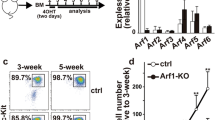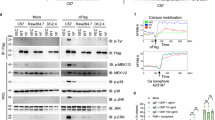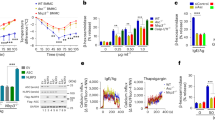Abstract
Mast cells have key functions as effectors of immunoglobulin E–mediated allergic inflammatory diseases. Allergen stimulation induces Ca2+ influx and elicits the secretion of inflammatory mediators from mast cells. Here we show that the Ca2+-binding endoplasmic reticulum protein STIM1 is critical to mast cell function. STIM1-deficient fetal liver–derived mast cells had impaired Ca2+ influx mediated by the high-affinity immunoglobulin E receptor FcεRI and activation of the transcription factors NF-κB and NFAT. Mast cells lacking STIM1 also had much less degranulation and cytokine production after FcεRI stimulation. In addition, alterations in STIM1 expression affected the sensitivity of immunoglobulin E–mediated immediate-phase anaphylactic responses in vivo. Thus, STIM1 is key in promoting the Ca2+ influx that is essential for FcεRI-mediated mast cell activation and anaphylaxis.
This is a preview of subscription content, access via your institution
Access options
Subscribe to this journal
Receive 12 print issues and online access
$209.00 per year
only $17.42 per issue
Buy this article
- Purchase on Springer Link
- Instant access to full article PDF
Prices may be subject to local taxes which are calculated during checkout






Similar content being viewed by others
References
Wedemeyer, J., Tsai, M. & Galli, S.J. Roles of mast cells and basophils in innate and acquired immunity. Curr. Opin. Immunol. 12, 624–631 (2000).
Bischoff, S.C. Role of mast cells in allergic and non-allergic immune responses: comparison of human and murine data. Nat. Rev. Immunol. 7, 93–104 (2007).
Kraft, S. & Kinet, J.P. New developments in FcεRI regulation, function and inhibition. Nat. Rev. Immunol. 7, 365–378 (2007).
Parekh, A.B. & Penner, R. Store depletion and calcium influx. Physiol. Rev. 77, 901–930 (1997).
Parekh, A.B. & Putney, J.W., Jr. Store-operated calcium channels. Physiol. Rev. 85, 757–810 (2005).
Clapham, D.E. TRP channels as cellular sensors. Nature 426, 517–524 (2003).
Hoth, M. & Penner, R. Depletion of intracellular calcium stores activates a calcium current in mast cells. Nature 355, 353–356 (1992).
Parekh, A.B., Fleig, A. & Penner, R. The store-operated calcium current ICRAC: nonlinear activation by InsP3 and dissociation from calcium release. Cell 89, 973–980 (1997).
Feske, S. et al. A mutation in Orai1 causes immune deficiency by abrogating CRAC channel function. Nature 441, 179–185 (2006).
Vig, M. et al. CRACM1 is a plasma membrane protein essential for store-operated Ca2+ entry. Science 312, 1220–1223 (2006).
Zhang, S.L. et al. Genome-wide RNAi screen of Ca2+ influx identifies genes that regulate Ca2+ release-activated Ca2+ channel activity. Proc. Natl. Acad. Sci. USA 103, 9357–9362 (2006).
Roos, J. et al. STIM1, an essential and conserved component of store-operated Ca2+ channel function. J. Cell Biol. 169, 435–445 (2005).
Liou, J. et al. STIM is a Ca2+ sensor essential for Ca2+-store-depletion-triggered Ca2+ influx. Curr. Biol. 15, 1235–1241 (2005).
Baba, Y. et al. Coupling of STIM1 to store-operated Ca2+ entry through its constitutive and inducible movement in the endoplasmic reticulum. Proc. Natl. Acad. Sci. USA 103, 16704–16709 (2006).
Luik, R.M. & Lewis, R.S. New insights into the molecular mechanisms of store-operated Ca2+ signaling in T cells. Trends Mol. Med. 13, 103–107 (2007).
Mercer, J.C. et al. Large store-operated calcium selective currents due to co-expression of Orai1 or Orai2 with the intracellular calcium sensor, Stim1. J. Biol. Chem. 281, 24979–24990 (2006).
Xu, P. et al. Aggregation of STIM1 underneath the plasma membrane induces clustering of Orai1. Biochem. Biophys. Res. Commun. 350, 969–976 (2006).
Wu, M.M., Buchanan, J., Luik, R.M. & Lewis, R.S. Ca2+ store depletion causes STIM1 to accumulate in ER regions closely associated with the plasma membrane. J. Cell Biol. 174, 803–813 (2006).
Stathopulos, P.B., Li, G.Y., Plevin, M.J., Ames, J.B. & Ikura, M. Stored Ca2+ depletion-induced oligomerization of stromal interaction molecule 1 (STIM1) via the EF-SAM region: an initiation mechanism for capacitive Ca2+ entry. J. Biol. Chem. 281, 35855–35862 (2006).
Ozawa, K. et al. Ca2+-dependent and Ca2+-independent isozymes of protein kinase C mediate exocytosis in antigen-stimulated rat basophilic RBL-2H3 cells. Reconstitution of secretory responses with Ca2+ and purified isozymes in washed permeabilized cells. J. Biol. Chem. 268, 1749–1756 (1993).
Nishida, K. et al. FcεRI-mediated mast cell degranulation requires calcium-independent microtubule-dependent translocation of granules to the plasma membrane. J. Cell Biol. 170, 115–126 (2005).
Odom, S. et al. Negative regulation of immunoglobulin E-dependent allergic responses by Lyn kinase. J. Exp. Med. 199, 1491–1502 (2004).
Parravicini, V. et al. Fyn kinase initiates complementary signals required for IgE-dependent mast cell degranulation. Nat. Immunol. 3, 741–748 (2002).
Nishizumi, H. & Yamamoto, T. Impaired tyrosine phosphorylation and Ca2+ mobilization, but not degranulation, in lyn-deficient bone marrow-derived mast cells. J. Immunol. 158, 2350–2355 (1997).
Hernandez-Hansen, V. et al. Dysregulated FcεRI signaling and altered Fyn and SHIP activities in Lyn-deficient mast cells. J. Immunol. 173, 100–112 (2004).
Putney, J.W., Jr. Store-operated calcium channels: how do we measure them, and why do we care? Sci. STKE 2004, pe37 (2004).
Hofer, A.M., Fasolato, C. & Pozzan, T. Capacitative Ca2+ entry is closely linked to the filling state of internal Ca2+ stores: a study using simultaneous measurements of ICRAC and intraluminal. J. Cell Biol. 140, 325–334 (1998).
Siraganian, R.P. Mast cell signal transduction from the high-affinity IgE receptor. Curr. Opin. Immunol. 15, 639–646 (2003).
Klemm, S. et al. The Bcl10-Malt1 complex segregates FcεRI-mediated nuclear factor κB activation and cytokine production from mast cell degranulation. J. Exp. Med. 203, 337–347 (2006).
Chen, Y. et al. B cell lymphoma 10 is essential for FcεR-mediated degranulation and IL-6 production in mast cells. J. Immunol. 178, 49–57 (2007).
Monticelli, S., Solymar, D.C. & Rao, A. Role of NFAT proteins in IL13 gene transcription in mast cells. J. Biol. Chem. 279, 36210–36218 (2004).
Klein, M. et al. Specific and redundant roles for NFAT transcription factors in the expression of mast cell-derived cytokines. J. Immunol. 177, 6667–6674 (2006).
Dolmetsch, R.E., Lewis, R.S., Goodnow, C.C. & Healy, J.I. Differential activation of transcription factors induced by Ca2+ response amplitude and duration. Nature 386, 855–858 (1997).
Healy, J.I. et al. Different nuclear signals are activated by the B cell receptor during positive versus negative signaling. Immunity 6, 419–428 (1997).
Dziadek, M.A. & Johnstone, L.S. Biochemical properties and cellular localisation of STIM proteins. Cell Calcium 42, 123–132 (2007).
Olivera, A. et al. The sphingosine kinase-sphingosine-1-phosphate axis is a determinant of mast cell function and anaphylaxis. Immunity 26, 287–297 (2007).
Mathes, C., Fleig, A. & Penner, R. Calcium release-activated calcium current (ICRAC) is a direct target for sphingosine. J. Biol. Chem. 273, 25020–25030 (1998).
Blank, U. & Rivera, J. The ins and outs of IgE-dependent mast-cell exocytosis. Trends Immunol. 25, 266–273 (2004).
Bonifacino, J.S. & Glick, B.S. The mechanisms of vesicle budding and fusion. Cell 116, 153–166 (2004).
Manetz, T.S. et al. Vav1 regulates phospholipase cgamma activation and calcium responses in mast cells. Mol. Cell. Biol. 21, 3763–3774 (2001).
Saitoh, S. et al. The four distal tyrosines are required for LAT-dependent signaling in FcεRI-mediated mast cell activation. J. Exp. Med. 198, 831–843 (2003).
Pivniouk, V.I. et al. SLP-76 deficiency impairs signaling via the high-affinity IgE receptor in mast cells. J. Clin. Invest. 103, 1737–1743 (1999).
Hashimoto, A. et al. Involvement of guanosine triphosphatases and phospholipase C-γ2 in extracellular signal-regulated kinase, c-Jun NH2-terminal kinase, and p38 mitogen-activated protein kinase activation by the B cell antigen receptor. J. Exp. Med. 188, 1287–1295 (1998).
Hirasawa, N., Santini, F. & Beaven, M.A. Activation of the mitogen-activated protein kinase/cytosolic phospholipase A2 pathway in a rat mast cell line. Indications of different pathways for release of arachidonic acid and secretory granules. J. Immunol. 154, 5391–5402 (1995).
Jiang, A., Craxton, A., Kurosaki, T. & Clark, E.A. Different protein tyrosine kinases are required for B cell antigen receptor-mediated activation of extracellular signal-regulated kinase, c-Jun NH2-terminal kinase 1, and p38 mitogen-activated protein kinase. J. Exp. Med. 188, 1297–1306 (1998).
Schulze-Luehrmann, J. & Ghosh, S. Antigen-receptor signaling to nuclear factor κB. Immunity 25, 701–715 (2006).
Shinohara, H. et al. PKCβ regulates BCR-mediated IKK activation by facilitating the interaction between TAK1 and CARMA1. J. Exp. Med. 202, 1423–1431 (2005).
Nechushtan, H., Leitges, M., Cohen, C., Kay, G. & Razin, E. Inhibition of degranulation and interleukin-6 production in mast cells derived from mice deficient in protein kinase Cβ. Blood 95, 1752–1757 (2000).
Rivera, J. Adaptors discriminate mast-cell cytokine production from eicosanoid production and degranulation. Trends Immunol. 27, 251–253 (2006).
Timmerman, L.A., Clipstone, N.A., Ho, S.N., Northrop, J.P. & Crabtree, G.R. Rapid shuttling of NF-AT in discrimination of Ca2+ signals and immunosuppression. Nature 383, 837–840 (1996).
Shibasaki, F., Price, E.R., Milan, D. & McKeon, F. Role of kinases and the phosphatase calcineurin in the nuclear shuttling of transcription factor NF-AT4. Nature 382, 370–373 (1996).
Oritani, K. & Kincade, P.W. Identification of stromal cell products that interact with pre-B cells. J. Cell Biol. 134, 771–782 (1996).
Kabu, K. et al. Zinc is required for FcεRI-mediated mast cell activation. J. Immunol. 177, 1296–1305 (2006).
Acknowledgements
We thank A. Ito for technical assistance; P.W. Kincade for critical review of the manuscript; and S. Yamasaki and H. Shinohara for discussions. The pMX-puro retroviral vector was from T. Kitamura (University of Tokyo). Supported the Ministry of Education, Culture, Sports, Science and Technology of Japan (Y.B. and T.K.).
Author information
Authors and Affiliations
Contributions
Y.B. designed and coordinated the study, did experiments, analyzed data and wrote the paper; K.N., Y.F. and M.H. cooperated in experiments; T.K. wrote the paper; and T.H. contributed to manuscript writing.
Corresponding author
Supplementary information
Supplementary Text and Figures
Supplementary Figures 1–2, Methods and References (PDF 682 kb)
Rights and permissions
About this article
Cite this article
Baba, Y., Nishida, K., Fujii, Y. et al. Essential function for the calcium sensor STIM1 in mast cell activation and anaphylactic responses. Nat Immunol 9, 81–88 (2008). https://doi.org/10.1038/ni1546
Received:
Accepted:
Published:
Issue Date:
DOI: https://doi.org/10.1038/ni1546
This article is cited by
-
Modulating effect of Eunkyo-san on expression of inflammatory cytokines and angiotensin-converting enzyme 2 in human mast cells
In Vitro Cellular & Developmental Biology - Animal (2024)
-
STIM1 in tumor cell death: angel or devil?
Cell Death Discovery (2023)
-
GPR40 activation initiates store-operated Ca2+ entry and potentiates insulin secretion via the IP3R1/STIM1/Orai1 pathway in pancreatic β-cells
Scientific Reports (2019)
-
Stimulus strength determines the BTK-dependence of the SHIP1-deficient phenotype in IgE/antigen-triggered mast cells
Scientific Reports (2018)
-
A dual mechanism promotes switching of the Stormorken STIM1 R304W mutant into the activated state
Nature Communications (2018)



